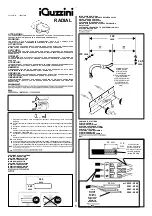
FCC Statement
This device complies with part 15 of the FCC Rules and Industry
Canada license-exempt RSS standard(s). Operation is subject to
the following two conditions: (1) this device may not cause
harmful interference, and (2) this device must accept any
interference received, including interference that may cause
undesired operation.
FCC NOTE: The manufacturer is not responsible for any radio or
TV interference caused by unauthorized modifications to this
equipment. Such modifications could void the user’s authority to
operate the equipment.
NOTE: This equipment has been tested and found to comply
with the limits for a Class B digital device, pursuant to Part 15 of
the FCC Rules. These limits are designed to provide reasonable
protection against harmful interference in a residential installation.
This equipment generates, uses and can radiate radio frequency
energy and, if not installed and used in accordance with the
instructions may cause harmful interference to radio communi-
cations. However, there is no guarantee that interference will not
occur in a particular installation. If this equipment does cause
harmful interference to radio or television reception, which can
be determined by turning the equipment off and on, the user is
encourage to try to correct the interference by one or more of
the following measures:
• Reorient or relocate the receiving antenna.
• Increase the separation between the equipment and receiver.
• Connect the equipment into an outlet on a circuit different from
that to which the receiver is connected.
• Consult the dealer or an experienced radio/TV technician
for help.
CAN ICES-3(B)/NMB-3(B)
Reglas de la FCC
Este dispositivo cumple con el apartado 15 de las normas de la
FCC y con los estándares RSS exentos de licencia de Industry
Canada. La operación está sujeta a las siguientes dos condiciones:
(1) este dispositivo no puede causar interferencias perjudiciales
y (2) este dispositivo debe aceptar cualquier interferencia
recibida, incluidas las interferencias que puedan provocar una
operación indeseable.
FCC NOTA: Los cambios o modificaciones a esta unidad que no
hayan sido expresamente aprobados por la parte responsable
del cumplimiento de las reglas, pueden anular la autoridad del
usuario para poder operar el equipo.
NOTA: Este equipo ha sido probado y cumple con los límites para
un dispositivo digital de Clase B, de conformidad con la Parte 15
de las Normas de la FCC. Estos límites están diseñados para pro-
porcionar una protección razonable contra interferencias en una
instalación residencial. Este equipo genera, utiliza y puede irradiar
energía de radiofrecuencia y, si no se instala y utiliza de acuerdo
con las instrucciones, puede causar interferencia dañina a la co-
municación por radio. Sin embargo, no hay ninguna garantía que
no ocurra interferencia en una instalación en particular. Si este
equipo causa interferencias perjudiciales a la recepción de radio o
televisión, esto se puede comprobar apagando y encendiendo el
equipo repetidamente, se le sugiere al usuario tratar de remediar
la interferencia tomando una o más de las siguientes medidas.
• Reorientar o reubicar la antena de recepción.
• Aumentar la separación entre el equipo y el receptor.
• Conectar el equipo a un tomacorriente en un circuito distinto
de aquel al que está conectado el receptor.
• Consultar al distribuidor o a un técnico de radio / TV para
obtener ayuda.
CAN ICES-3(B)/NMB-3(B)
Mounting
template
The lantern can be easily
screw-mounted to walls
or ceilings using this
handy template.
1. Use template to install two
#6 screws with the head
extending about 1/4” from
the mounting surface.
2. Use the keyhole slots in
the base to securely mount
the lantern to the screws.
Plantilla
de montaje
The lantern can be easily
screw-mounted to walls
or ceilings using this
handy template.
1. Use template to install two
#6 screws with the head
extending about 1/4” from
the mounting surface.
2. Use the keyhole slots in
the base to securely mount
the lantern to the screws.






















